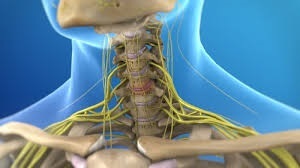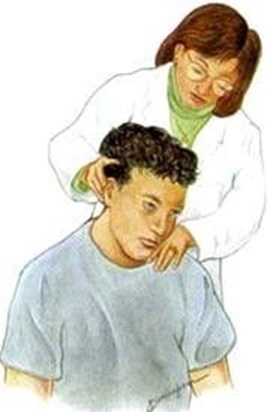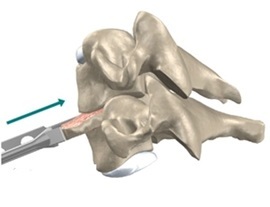Degenerative disc disease (osteochondrosis) in the area of the cervical spine is the primary cause of pain manifestations in the neck and irradiiruet pain in the hands. Painful symptoms to manifest begin when one or more intervertebral discs in the cervical spine begin to break down because of the Degeneration.
The predisposition of some human diseases to the development of degenerative disc, maybe a genetic component. Trauma can also spine acceleration and sometimes cause the development of degenerative changes in the neck.
The treatment of osteochondrosis of the cervical spine gives good results only if it has a regular character and is a consistent and systematic. Osteochondrosis of the cervical spine, the most common causes of symptoms in patients of working age who sit long at the Computer is not in the list. Often the patients are not paying attention to the pain and do not seek treatment , which can lead to complications.
Risk factors for degenerative disc disease of the cervical spine

While almost all people sooner or later degenerative changes in the neck develop involuto generic spine, there are some factors that make more likely the early development or the onset of degenerative disc disease symptoms. These risk factors can be:
- The Genetics. Some twin studies show that genetics plays a greater role than lifestyle in the early development of degenerative disc disease in the cervical spine, and quick debut of symptoms.
- Obesity. Weight associated with the risk of developing degenerative diseases (osteochondrosis).
- Smoking. This habit can prevent the supply of nutrients in the discs and accelerate hydration.
- In addition, injury to the spine can sometimes start or speed up the process of Degeneration in the cervical spine.
Symptoms
The symptoms of degenerative disc disease of the cervical spine can vary greatly in different people.
As osteochondrosis becomes symptomatic, the pain may develop gradually or appear suddenly. The symptoms of weakness can vary from a few complaints in the neck tiring to severe pain radiating to the arm, numbness and / or muscle.
The main symptoms:
- Pain in the neck. Low-Intensive pain on the background of stiffness in the neck the most common Symptom of degenerative disc of the neck, diseases of the spine. But sometimes the pain can be amplified drastically, and take a few hours or days.
- Neuralgia. This type of pain tends to be acute, or with the feeling of electric shock, radiating to the shoulder in the arm, Hand and / or fingers. In General, neuralgia, there is only one side of the body.
- Neurological symptoms in the Hand, in the brush and / or fingers. Occur needles, tingling, numbness and / or weakness can spread to the entire upper extremity. These types of symptoms can interfere with daily activities, for example, to print, to dress, or keep objects.
- Pain worse for movement. Usually, the pain caused by degenerative disc itself usually worse with movement and decreases with rest.
- If the pain is coming from the degenerative disc, then you will likely disappear on their own within a few weeks or months. But there are also other symptoms of degenerative disc of the neck disorders of the spine often become chronic and require treatment, for example, if the facet joints in the neck also start to degenerate and / or compression of the nerve root.
Less common symptoms
The more cervical spine Alliance, the more likely it is that the spinal canal is narrowed and increasing the risk of spinal cord compression. If there is a compression of the spinal cord , then myelopathy will develop and symptoms appear, such as:
- The difficulty of the movement of the hands and / or feet
- Problems with coordination and / or Balance
- Loss of control of bowel and / or bladder
- Weakness and / or numbness anywhere below the neck
- Shooting pain in the extremities when bending over
A cervical myelopathy is a serious condition that requires immediate medical attention. This condition usually occurs in people older than 50 years.
Diagnosis
The diagnosis of osteochondrosis of the cervical spine will be calculated on the basis of such data, such as:
- Sick sheet. Firstly, the doctor must examine in detail the symptoms and medical history.
- A physical examination. Then the doctor will perform a physical examination, palpation of the neck and through the review of the range of motion in the neck. During the test, the patient may be asked to perform certain movements and to report increases or decreases neck pain.
- If the pain is intense, or if there are neurological symptoms, such as pain, tingling, or weakness in the shoulder, arm or Hand, then the doctor will, most likely, assign the implementation of the medical imaging .
- Methods of medical imaging (x-ray, CT, MRI, PET). If the physician determines that, in order to clarify the exact etiology of the symptoms is necessary to take a picture of the fabric (the drive) and then probably a scheduled MRI. MRI, or perhaps computed tomography can confirm the x-ray, whether the characteristics of the Degeneration, and other conditions (such as osteoarthritis or stenosis), the symptoms can cause.
- After the confirmation of the exact diagnosis of osteochondrosis of the cervical spine, as well as all other similar conditions, one can determine understand the Genesis of the symptoms and an effective treatment program.
Condition, associated with osteochondrosis of the cervical spine

Degeneration of the discs, which is often accompanied by other pathological conditions, caused either at the same time, or in some cases a different. Most of the following conditions occur:
- Herniated disc in the cervical spine occurs when the Degeneration of the intervertebral disc leads to disruption of the integrity of the Anulus fibrosus and protrusion of the contents outside of the ring. But a herniated disc can occur after an injury , the spine eventually accelerates the Degeneration of the disc and leads to the development of degenerative disc disease of the neck .
- Cervical Osteoarthritis. To reduce the dimensions of the Standard, such as the hard disk of the Alliance and the space in the spine begins, the facet joints can move start normal and cause wear and tear of the cartilage, but also the formation of osteophytes in the area of the neck to stimulate the spine.
- Cervical stenosis of the spine. This is a condition that occurs due to osteophytes or disc herniation, and narrowing of the spinal canal occurs (where the spinal cord runs), or foramina holes (where the nerve root).
But you have to understand that sometimes, with some people, already with the birth of a narrowing of the spinal canal and the development of the symptoms is not associated with osteoarthritis.
Cervical radiculopathy - symptoms include pain, tingling, numbness and / or weakness that radiate to the shoulder in the arm and Hand can occur if one or several nerve roots are pinched or irritated. If the stenosis occurs in the spinal cord compression herniated disc or osteophytes are associated, then myelopathy can develop. Possible symptoms may feel pain, tingling, numbness and / or weakness at this level in the area of the throat and anywhere below the level of the compression. For example, a Person may be tingling or weakness in the legs, problems with balance or even difficulties with the control of bowel and bladder.
If the symptoms of myelopathy go is important in medical treatment because the condition can progress, and without treatment, can eventually develop paralysis of the limbs, and dysfunction.
Treatment
In General, it will be spine when symptoms occur due to osteochondrosis of the cervical therapeutic measures on the reduction of symptoms. In the first line in the treatment of degenerative disc in the cervical spine, conservative treatment methods are diseases.

In rare cases, when the pain and the symptoms persist or worsen, despite treatment for several months, or if there is a risk of damage to the spinal cord, then the question of Operation is decided.
Possibilities of conservative treatment
For the treatment of neck pain, caused by osteoarthritis, a doctor usually recommends that one or more of the following treatment options:
- Vacation or lifestyle change. Some actions can be more painful for the neck, for example, the elongation of the neck, heated front seats with work on the Computer Abstinence or modification of certain activities for a few days or weeks, usually the pain decreases. In addition, it is recommended that the correct posture to maintain (instead of bending over when sitting or bending the neck to the heated seats in the front while driving, etc.). Healthy eating, adequate fluid intake and Smoking are also useful for the health of the CDs.
- Treatment of pain with the help of medications or injections. A special effect over-the-counter pain relievers can give. If the pain is intense, then it can be assigned to a stronger pain medication like oral steroids or muscle relaxants, or even opiates.
Injections, such as facet injections, nerve or epidural blocks. This also includes the injection of corticosteroids in a specific structure to reduce local inflammation can:
- Tail epidural injections
- Injection of the facet joints
- Interlaminar tail epidural Steroid injections
- Transforaminal epidural injections
- Selective Blockade of nerve roots
- Blockade of the medial branches
- Ice and heat can be used in the treatment of degenerative disc disease of the cervical spine.
- Movement therapy. The most a non-surgical programs for the treatment of degenerative disc disease of the cervical spine include specific exercise programs, such as isometric, so strength and tensile strength .Selection of the exercises needs to have a qualified Person ( doctor, physiotherapist) , because of insufficient exercises lead to a worsening of the condition . In addition, exercises should be selected taking into account the individual characteristics of each Person . Overall, an increase in the strength and flexibility in the neck area, can the pain and the risk, to some extent, Standard to slow, degenerative changes in the discs.
- The Manual Therapy. The cervical spine can be manually set by qualified personnel in the areas of health, to improve mobility and / or pain to reduce. Depending on the patient's symptoms, a physical examination and / or visualization prior to manual Manipulation of the neck must.
- Physiotherapy
- Massage
- Acupuncture
- Corethrogyne
Surgical treatment of degenerative disc disease of the cervical spine
The operational methods of treatment of degenerative disc disease of the cervical spine in the rule in two cases:
- Neurological symptoms such as constant numbness in the hands and / or weakness, or problems with walking or control of the bowel. If neurological symptoms caused by spinal osteochondrosis of the neck, consists of a the risk of irreversible damage to the nerves, and may recommend surgery to reduce pressure on the nerve.
- Chronic pain is a serious and untreatable for at least six months of non-surgical treatment, and daily activity is difficult. The best surgical results of the projections for patients with chronic pain in conjunction with other conditions, such as, for example, the instability of the motor segments of the cervical and / or radiculopathy.
The most important surgical procedure for the treatment of degenerative disc disease of the spine:
- Anterior cervical discectomy and Fusion (ACDF).
- Replacement of the artificial disc.
In addition, there are a number of other surgical procedures for the treatment of degenerative disc of the neck, diseases of the spine:

- Endoscopic Decompression
- Endoscopic is foraminotomy
- Percutaneous Decompression
- Intradiscal therapy electro thermal
- Selective endoscopic discectomy
- The Stimulation of the spinal cord
- Radio-Frequency Ablation
- Epidural lysis of adhesions
Surgical interventions on the neck, decompression of the nerve roots and / or spinal cord and hence the reduction of neurological symptoms, such as pain or weakness in the hands, tends to be a good long-term results and positive forecast is between 80% to 90% .

































